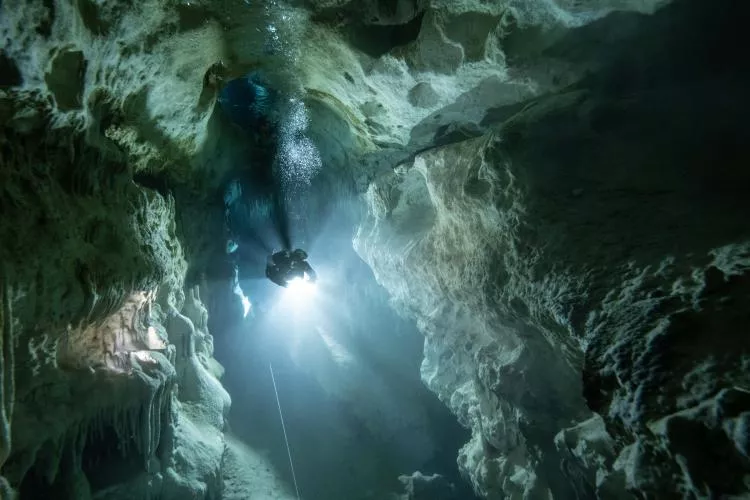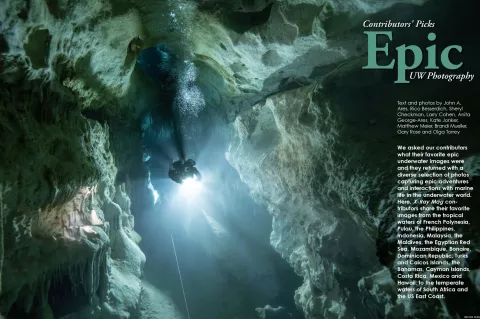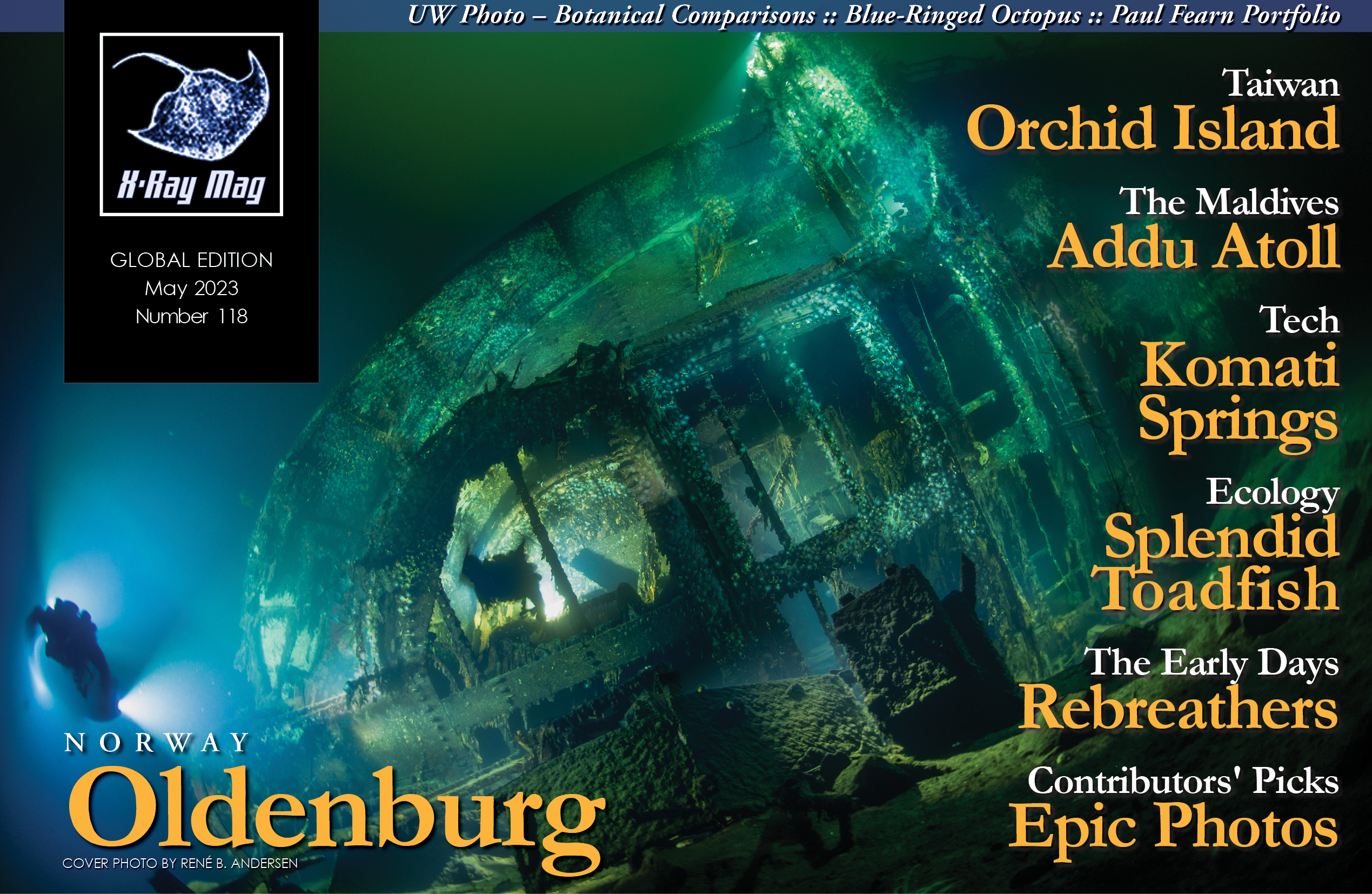We asked our contributors what their favorite epic underwater images were and they returned with a diverse selection of photos capturing epic adventures and interactions with marine life in the underwater world. Here, X-Ray Mag contributors share their favorite images from the tropical waters of French Polynesia, Pulau, the Philippines, Indonesia, Malaysia, the Maldives, the Egyptian Red Sea, Mozambique, Bonaire, Dominican Republic, Turks and Caicos Islands, the Bahamas, Cayman Islands, Costa Rica, Mexico and Hawaii, to the temperate waters of South Africa and the US East Coast.
Contributed by
(To see all images, please scroll down to the end and download the article PDF)
Unexpected Experiences
Text and photos by Brandi Mueller
When I think about epic shots, my mind immediately starts searching my memory bank for impressive and often unexpected underwater experiences or images that came from a unique environment.
One of my favorite moments in the ocean took place on a trip to South Africa where I was in a skiff of divers, following a massive pod of dolphins, which turned out to be pursued by killer whales (Photo 1). We watched seven orcas isolate one of the slower-swimming dolphins and play with it before eating it. After that, we jumped in the water for a quick snorkel with the orcas and could hear their loud echolocation as they scanned us with sound (Photo 2).
I also think about images taken in the most epic underwater environment I have ever been in: caves. These shots (Photo 3 and 4) required dives without a camera to find a spot to shoot; followed by above-water drawings and discussions with a team of divers willing to spend an entire dive in an attempt to make one image; and then carrying a lot of lights and other equipment into the cave to light the scene. Not to mention, it also required amazing models who were willing to hover for over an hour to get the shot. I have some pretty “epic” dive buddies. Visit:
brandiunderwater.com
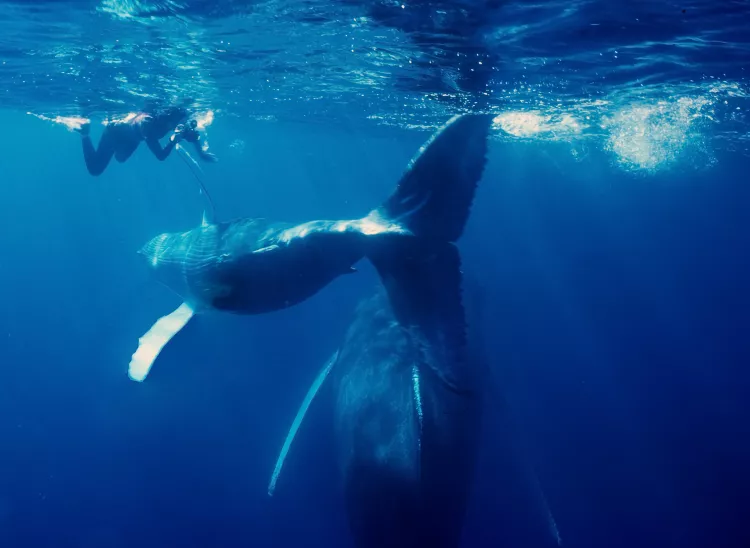
Big Animals
Text and photos by John A. Ares
When I think about the word “epic” in respect to underwater subjects, I think of both shipwrecks and big animals. Big animals won out for this article.
Photo 1 depicts an epic night dive with several manta rays in the Maldives. While two rays are clearly visible, there is the tail of a third ray on the right side of the top manta. Epic.
Photo 2 is also from the Maldives, where I was “adopted” by a six-foot-long tawny nurse shark. The sharks gather here in groups of one to three dozen, as they are routinely fed scraps by a local restaurant. Tawny nurse sharks are very docile. This shark posed for its portrait for about ten minutes.
The humpback whales in Photo 3 were photographed in Silver Bank, halfway between the Turks and Caicos Islands and the Dominican Republic. The snorkeler shows the scale in relation to the 15ft-long calf and its 45ft-long mother below.
Few experiences underwater are as attention-grabbing as coming face-to-face with a great white shark. Photo 4 was shot from a cage at Guadalupe Island in Mexico. The photo was converted to black and white using Nik Silver Efex Pro 2 software. Visit: JohnAres.com
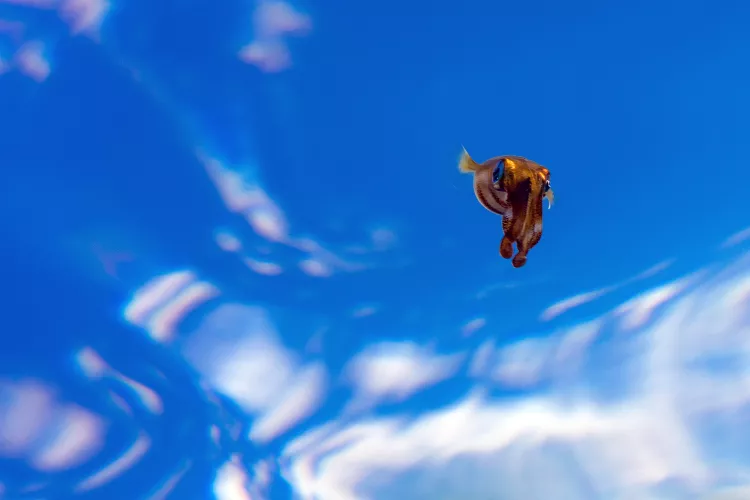
Epic Shots
Text and photos by Rico Besserdich
The request to deliver “epic” shots made me think a lot about what “epic” actually means and how it could (or should not) be used in the world of photography. The Oxford English Dictionary states: “Epic: A long poem, typically one derived from ancient oral tradition, narrating the deeds and adventures of heroic or legendary figures or the past history of a nation.”
Hmm... is a squid a heroic figure? As I understood it, the Iliad and the Nibelungenlied (The Song of the Nibelungs) are epic works, but my images are not. My search continued…
Looking at the lingo of the “whassup?”, “bbl” and “lol” generation—and let’s not forget ROFL (or “rolling on the floor laughing”)—the Merriam-Webster dictionary then explained to me that the term “epic has been found used in a highly colloquial fashion, in a manner that is largely synonymous with outstanding, fabulous, or impressive.”
Aha. Outstanding, fabulous, impressive. We are getting closer. However, what is “fabulous” to one may be perceived entirely differently by someone else. ROFL!
For me (if I could even dare to place a definition on it), an “epic” image is an image that impresses viewers for longer than just a few seconds, making them think and wonder. Most of all, it should be a visual work that cannot be reproduced, meaning it is special and unique, and thus stands as a powerful milestone of imaging artwork, well beyond the classic notion that an image should “entertain for just five seconds.” To me, something epic is also something timeless… something a photographer can hope to be remembered for. Visit: maviphoto.com
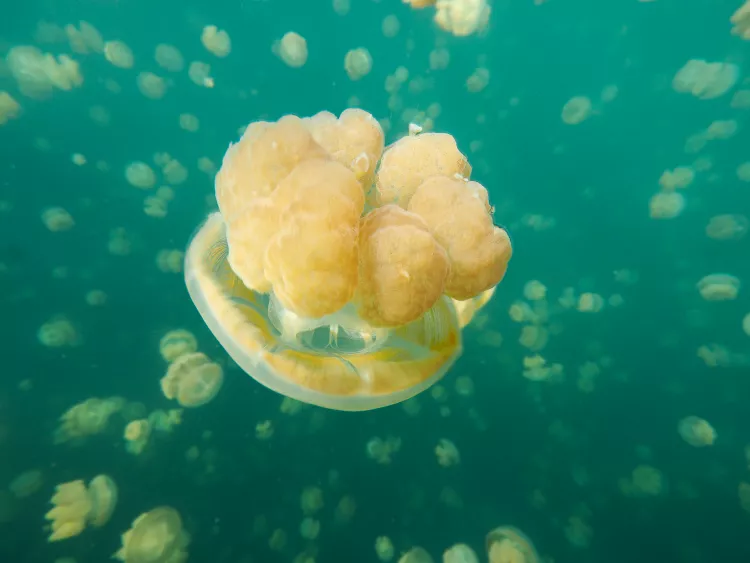
Wide-Angle Proportions
Text and photos by Sheryl Checkman
What makes an image epic? It could be the unique perspective that super wide-angle or close-focus wide-angle can give to a subject or landscape, or the way a leading line brings you into an image so that you feel a part of it.
When I went to Jellyfish Lake in Palau, I was blown away by the sheer number of stingless jellyfish that surrounded me. I had so much fun with the endless possibilities for photographing them that I did not want to get out of the water! For this article, I chose a close-focus wide-angle shot of a single jellyfish in the foreground (Photo 1), its epic proportions in relation to the background makes it look like a spaceship flying through space.
The sea fan (Photo 2) that I shot on the Joy’s Joy dive site in Little Cayman was shot super wide-angle with my 8mm fisheye lens, making it appear larger than life.
At the beginning of a dive on the Blue House site in Alor, Indonesia, I looked up to see a freediving spearfisher suspended in the water (Photo 3). Another diver, on scuba, looked up at him from the depths below. To me, the juxtaposition of these two divers, from my perspective, makes this an epic photo.
The curved line of bluestripe snappers (Photo 4) schooling through Sherwood Forest in Mozambique was a truly magical sight, as they weaved their way through the “forest” of green, tree-like coral. This super wide-angle view leads the viewer right into the entire scene. Visit: Instagram.com/sherylcheckman
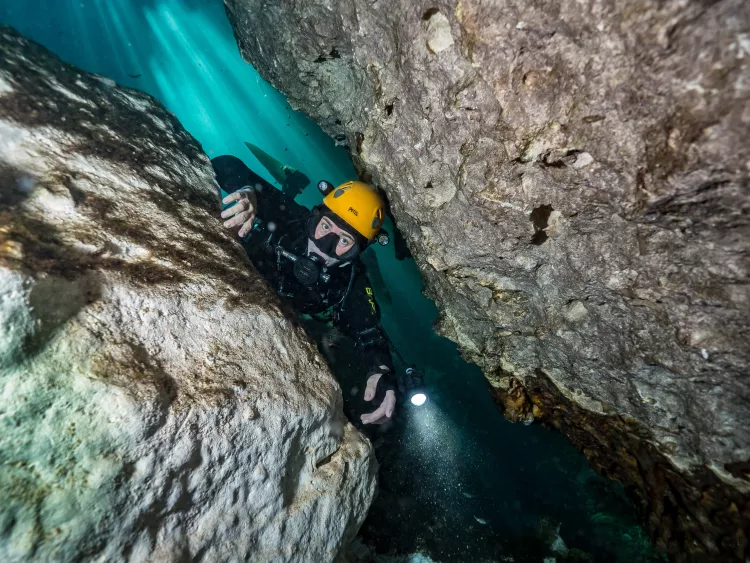
Magical Cenotes
Text and photos by Larry Cohen
Diving in one of the flooded caves in the Mexican Yucatán is as close as one can get to being on a different planet while still on Earth. As a photographer, capturing images in the dark is challenging, but capturing nature’s light show in the cenotes offers many possibilities.
A cenote is formed when a cave ceiling collapses. When this happens, a pool is created that becomes an entrance to the underworld. Tourists and locals use these pools to escape the heat; for cave divers, it is the entrance to an adventure.
On sunny days, light streams into the dark area of the caverns, creating patterns and sunbeams that are breathtaking to the eye. Capturing this light can produce an epic photograph.
It is good to have a diver model in the image and use just enough strobe light to open up the shadows and capture details in the subject. It is essential not to use too much artificial light, so that the ambient light effects are not overpowered. Visit: liquidimagesuw.com
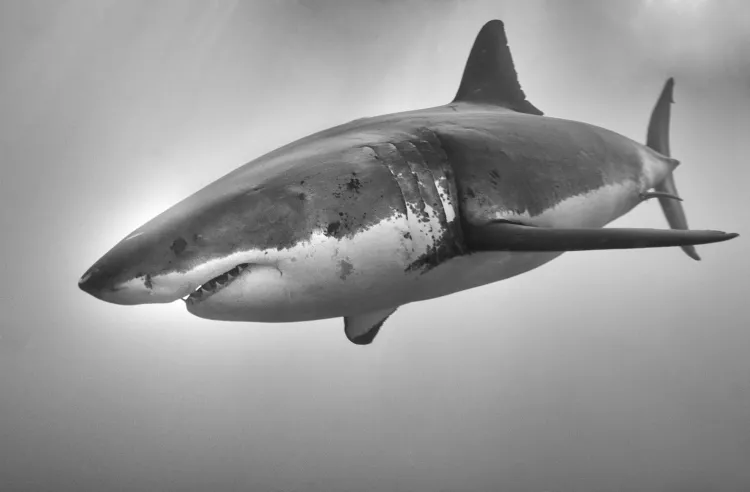
Epic Encounters
Text and photos by Anita George-Ares, PhD
For me, “epic” means experiencing an awesome encounter up close with a big marine animal. The image of the great white shark in Photo 1 was shot from a cage. It was easier to shoot with available light than to use my big Ikelite strobes in a cage with several divers all on hookah rigs.
Strobes and scuba are not permitted when shooting whale sharks in Oslob and humpback whales in Moorea. In order to take the image of the calf in Photo 2, I slipped into the water quietly from the boat, then snorkeled on the surface for 300 yards. Government rules prevent boats from approaching closer than 300 yards to mothers with calves. Freediving and the wearing of weight belts are not permitted. Calves need to frequently come to the surface to breathe, so there are still plenty of opportunities to take images.
The whale shark in Photo 3 was in a vertical position as it was surface feeding. This behavior occurs as the whale sharks at Oslob are fed shrimp by the local fishermen. In recent years, Oslob has become overcrowded with tourists. This image was taken in 2013 when there was not such a high density of tourists in the water.
The Maldives are known for their reef manta rays and manta cleaning stations. Mantas continually circle a reef area in order to be cleaned by small fish. I like the diagonal composition and feeling of motion that this manta ray image (Photo 4) conveys.
Images were converted to black and white using Nik Silver Efex Pro 2. Please visit: facebook.com/profile.php?id=100016947967639
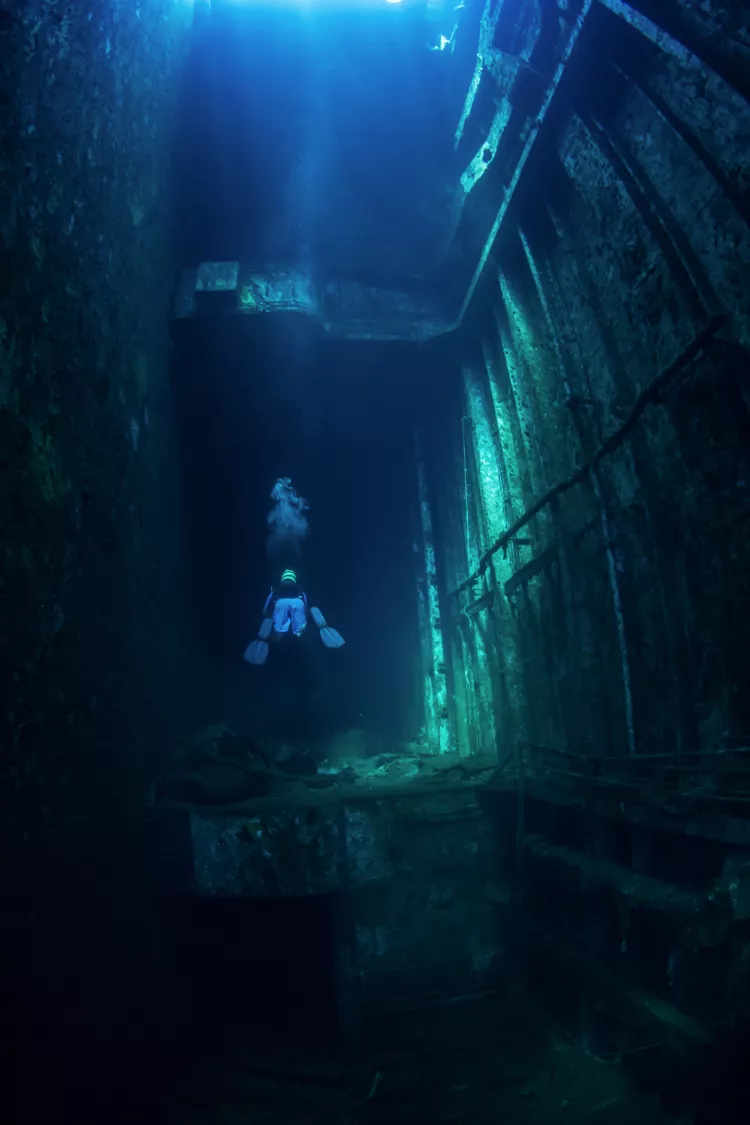
Vast Scale & Perspective
Text and photos by Kate Jonker
Epic underwater photography captures the awe-inspiring beauty of the vast underwater landscape. It is about exploring magnificent towering reefs and giant shipwrecks in crystal-clear waters, and conveying their “epic-ness” through the lens of a camera.
Traditionally, underwater photographers are taught to “shoot up,” but breaking this mould can create stunning images that truly convey the scale and magnitude of shipwrecks. Shooting from high above the wreck using a wide-angle lens and natural light to illuminate as much of the wreck as possible can give viewers an eagle-eye view, making them feel as if they are flying above it.
When photographing reefs, using a wide-angle lens can help capture the grand scale of larger portions of the reef, going beyond what the human eye would normally see. Adding a school of fish or a diver in the frame, with the dark profile of the reef in the background, can add depth and a sense of magnitude.
Including a diver in the shot can give the viewer a sense of perspective, highlighting the immense size of the reef or wreck. The sheer size of many wrecks with a tiny diver next to them can create a feeling of solitude, making a diver seem small and insignificant in comparison.
On clear days, capturing the underwater landscape’s epic proportions is easier. Adding the surface of the water, and possibly even the dive boat above, can help add an extra dimension to the shot.
In the end, the key to capturing epic underwater images is to think beyond traditional photography techniques and experiment with creative angles and lighting. With practice and patience, you can capture the majesty of the underwater world and create images that will leave your viewers in awe. Visit: katejonker.com
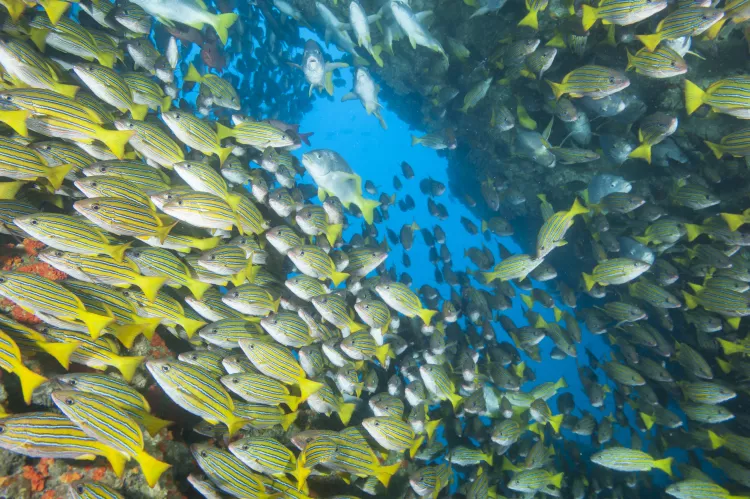
Epic Fish Encounters
Text and photos by Matthew Meier
With so many ways to interpret the word “epic,” I decided to relive a few of my awe-inspiring interactions with massive schools of fish. On my first trip to Bonaire, I happened upon what I now realize was likely a spawning migration of creole wrasse (Photo 1). For over 20 minutes, I watched as a constant stream of fish swam past a deep portion of the reef heading for destinations unknown.
A few years later, I had two very memorable moments at Cocos Island. The first involved hundreds of snappers and grunts, pulsing in the opening of an underwater cavern, as the heavy surge pushed us 10 to 15 feet in either direction (Photo 2). Then, later in the trip, I swam out into the blue, chasing a huge shadow off the pinnacle at Dirty Rock, to find a gigantic tornado of bigeye jacks twisting nearly to the surface from 60 feet down (Photo 3).
I had another two experiences with large schools of fish during a trip through Raja Ampat and Triton Bay. While shooting a colorful section of reef near Misool, I was overrun by a monstrous aggregation of fusiliers, damsels and anthias, which nearly blotted out the sun. I only wish I had been shooting with a fisheye lens to capture the full spectacle. Finally, near Tanjung Papisoi in Indonesia, I came across the largest schools of golden sweepers and glass fish I had ever seen (Photo 4). They filled a huge gap in the reef, moving in unison with frenetic energy, and I spent a large portion of that dive observing and photographing the spectacle. Visit: MatthewMeierphoto.com
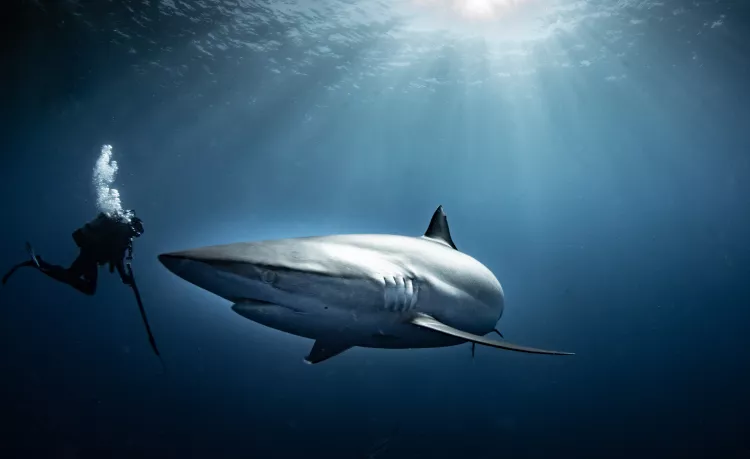
Why Epic?
Text and photos by Gary Rose, MD
The word “epic,” as a noun, refers to “a long poem, typically one derived from ancient oral tradition… or the history of a nation.” As an adjective in underwater photography, “epic” refers to shooting to the extreme and using techniques that emphasize the subject—such as wide-angle, extreme perspective, sfumato and isolation. My definition of an epic photo is one that evokes strong emotion upon viewing, and then lingers in the mind for hours or days. These are some of my favorite techniques to use for creating dramatic photos, which are the images that I often exhibit in galleries and shows.
Sharks are my favorite subjects for epic photographs. Just the very subject—sharks—inspires me to create. The tiger shark is easily recognized (by most viewers) by its gorgeous markings and inherently huge size. Photo 1 demonstrates isolation and size. Viewers always ask me, “How did you get this photo?” Well, I used a very wide-angle lens and literally shot straight down between my legs as they straddled her in the frame. If my legs were not stretched to the max, you would be able to see my diving fins. It is Epic.
Photo 2 is a close-up of a great white shark, taken at an angle that emphasizes size, strength and movement. Most viewers are used to only seeing photos of great whites from cages or on the surface of the sea. The beauty of this photo is that it was not from within a cage (implying hidden danger), but in open water, against a salutary deep blue negative space, which highlights the magnificent coloring of the great white shark. When I display this photo, I cut it into a tryptic (in homage to Damien Hirst), which further emphasizes dramatic movement and depth—Epic.
I love great hammerhead sharks. I get excited every time I see them and photograph them. They are unusual and exceptionally photogenic. As demonstrated in Photo 3, I used an Italian Renaissance technique called “sfumato.” As you can easily see, the lighting is very soft, and all is out of focus except for the subject—the great hammerhead. This is also an extremely close-up wide-angle photo, which enhances the beauty of the sfumato effect. This is one of my favorite photos and is prominently displayed in my home.
Photo 3 appeared in my article on minimalist photography in issue #117. In the minimalist version, the stark white background produces tension, creating an effect where the great hammerhead appears to nearly pop right out of the photo. In contrast, as an epic photo in full color, using sfumato, the lighting is very soft and out of focus, except for the subject, engendering a feeling of peace and calm.
The color, lighting and unusual perspective of Photo 4, as well as the subject of an encounter between diver and shark, propel this photo into the realm of Epic. The contrast of dark and light, with the shark at the transition, emphasizes the ageless story of human-animal encounters. The cathedral lighting also enhances the symbolism of this encounter. I consider this encounter as a hauntingly beautiful epic.
Photo 4 previously appeared in my article featuring black-and-white photography in issue #110. As a black-and-white photo, the emphasis was on the play of light—the sunburst and corona encircling the shark. In contrast, as an epic photo in full color, it draws the viewer’s attention to the subject—the extraordinary encounter of diver and shark.
Whenever I look at my raw photos, I try to “feel” what I am seeing. I shift from left brain to right brain, or hover in the middle. Then, the magic happens. Visit: garyrosephotos.com
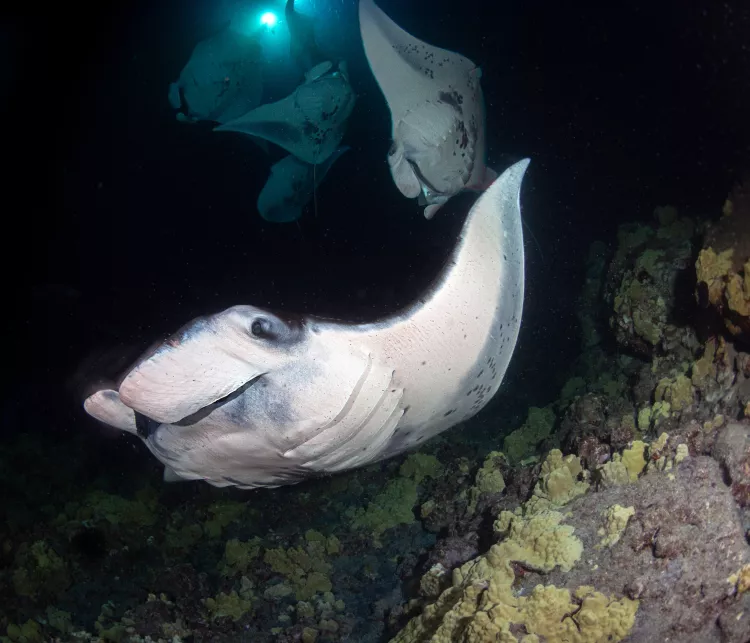
Grand Impressions
Text and photos by Olga Torrey
In Cozumel, Mexico, I dived sites with grand underwater arches formed by corals and sponges. I swam among these healthy reef walls, pinnacles and beautiful tunnels and had to use a fisheye lens to show the enormous size of the arches (Photo 1).
When I first visited Kailua-Kona Island, Hawaii, in October 2019, I went night diving with giant manta rays. I settled on the bottom with a group of divers in a large circle. Inside the circle were bright lights that cut through the water with powerful beams. The light attracted the plankton, and the plankton attracted several giant mantas gliding through the water, making graceful turns and flips (Photo 2). The mantas provided a mesmerizing experience and showed Kona’s nightlife at its best!
In July 2013, I dived on the Aeolus shipwreck for the first time. The vessel was part of an artificial reef in North Carolina, USA.[1] The dive was enjoyable because of the many sand tiger sharks inside the wreckage. These animals look ferocious with their jagged teeth to help with their big appetite! Sand tiger sharks are not aggressive towards people but should not be provoked. I descended on the wreck and faced the giant fish with curiosity and admiration. The sharks did not disappoint me and made excellent photo subjects (Photo 3).
The Phyllodesmium magnum is a type of aeolid nudibranch with a sophisticated arrangement of densely branched digestive glands perfectly positioned toward sunlight (Photo 4). The shape of the glands reminds me of the artwork of Columbian artist Fernando Botero whose signature style is exaggerated and voluptuous. Visit: fitimage.nyc
[1] Wikipedia.org

